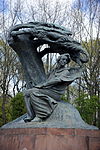Aleksander Kamiński Monument (Warsaw)
2006 establishments in Poland2006 sculpturesBronze sculptures in PolandBuildings and structures completed in 2006Busts in Poland ... and 7 more
Monuments and memorials in WarsawOutdoor sculptures in WarsawScouting in popular cultureSculptures of men in PolandSculptures of military officersUjazdów, WarsawWorld War II monuments and memorials in Warsaw

Aleksander Kamiński Monument (Polish: Pomnik Aleksandra Kamińskiego) is a sculpture in Warsaw, Poland, within the neighbourhood of Ujazdów in the Downtown district. It has a form of a bronze bust of Aleksander Kamiński, a 20th-century school teacher and soldier, who during the Second World War was one of leaders of the Grey Ranks resistance organisation in German-occupied Poland. The sculpture was designed by Wiesław Winkler and unveiled in 2006. It is located in the southeaster part of the Royal Baths Park, near the Egyptian Temple.
Excerpt from the Wikipedia article Aleksander Kamiński Monument (Warsaw) (License: CC BY-SA 3.0, Authors, Images).Aleksander Kamiński Monument (Warsaw)
Belwederska, Warsaw Midtown
Geographical coordinates (GPS) Address External links Nearby Places Show on map
Geographical coordinates (GPS)
| Latitude | Longitude |
|---|---|
| N 52.211454 ° | E 21.02858 ° |
Address
Aleksander "Kamyk" Kamiński
Belwederska
00-592 Warsaw, Midtown
Masovian Voivodeship, Poland
Open on Google Maps









